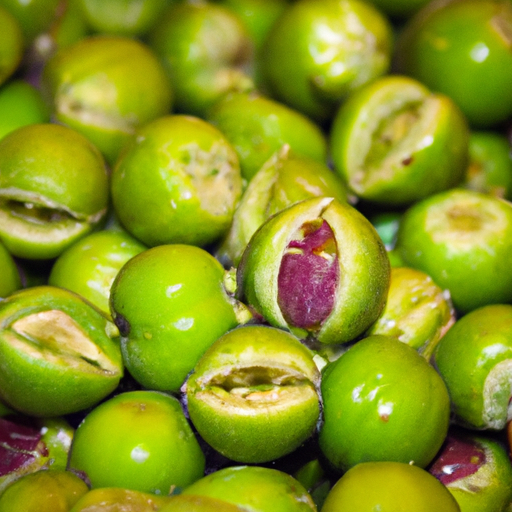Exploring the Delightful World of Caperberries
If you are a food enthusiast, you’ve probably heard of capers, those tiny, tangy, and flavorful buds that bring a burst of brininess to a variety of dishes. But have you ever tried caperberries? These slightly larger counterparts to capers are equally remarkable in their own right. In this blog post, we will take a deep dive into the captivating world of caperberries, exploring their taste, culinary uses, nutritional value, and uncovering some interesting history and facts. Let’s get started!
Taste Profile:
Caperberries possess a distinctive taste that is more delicate and less pungent than capers. With a texture resembling that of olives, these small fruits offer a refreshing combination of sourness, saltiness, and slight bitterness. The brine they are pickled in enhances their flavor profile, resulting in a tantalizing burst of tanginess that can elevate any dish they grace.
Culinary Applications:
Caperberries have found a cherished place in many kitchens around the world, enriching a wide array of dishes with their unique taste. Here are some common uses:
Antipasto Platters: Caperberries are a delightful addition to antipasto platters, offering a pop of flavor alongside cured meats, cheeses, olives, and marinated vegetables. They bring a beautiful balance to the richness of other ingredients.
Salads: Whether scattered whole or sliced, caperberries bring a refreshing zing to salads. They pair exceptionally well with bitter greens like arugula and radicchio, as well as feta or goat cheese.
Charcuterie: Placed alongside a variety of cured meats, caperberries create a delightful contrast of flavors and textures, providing a briny bite that cuts through the richness.
Garnishes: Caperberries can be used as a visually appealing and flavorful garnish on top of fish dishes, seafood stews, or served alongside poultry. They add a touch of elegance and sophistication to any plating.
Sauces and Condiments: Capers and caperberries are often used in the preparation of tangy sauces, such as Tartar sauce or Remoulade. They bring a tangy twist and complexity to the overall flavor profile.
Nutritional Highlights:
Caperberries not only enhance the taste of your dishes but also offer nutritional benefits. Here’s what they bring to the table:
Low in Calories: Caperberries are low in calories, making them a guilt-free addition to your meals or snacking repertoire.
Good Source of Antioxidants: These tiny berries are packed with powerful antioxidants that help protect the body against oxidative stress and inflammation.
Rich in Vitamins and Minerals: Caperberries boast a range of vitamins and minerals, including vitamin K, iron, and calcium. Vitamin K is crucial for blood clotting and bone health, while iron and calcium contribute to overall well-being.
Fun Facts:
Now that we’ve explored caperberries from a culinary perspective, let’s uncover some interesting facts:
Caperberries vs. Capers: Caperberries are the ripe fruits of the caper bush. In contrast, capers are the immature flower buds of the same plant. Though related, they have different flavors and textures, offering unique culinary experiences.
Historical Significance: Caperberries have a rich history dating back thousands of years. These ancient treasures were highly regarded by the Greeks and Romans and were even believed to have medicinal properties.
Mediterranean Delights: Caperberries are commonly found in Mediterranean cuisine, particularly in dishes hailing from Italy, Spain, and France. They lend their bold flavors to traditional recipes like vitello tonnato (veal with tuna sauce) and classic Niçoise salads.
Pickling Magic: To create caperberries, they are hand-picked and gently cured in a brine solution, allowing them to develop their distinct flavor profile. This pickling process helps preserve their taste, texture, and natural goodness.
Whether you’re a food enthusiast or an adventurous home cook, caperberries are a must-try ingredient that can elevate your culinary creations to new heights. Their tangy and refreshing taste, versatility in dishes, and nutritional benefits make them the perfect addition to your pantry. So, why not embark on a voyage of flavor and bring the delightful world of caperberries into your kitchen today?
Remember, when experimenting with caperberries, don’t shy away from your creativity. Embrace their unique qualities and let them shine in a dish of your own creation. Happy cooking!
Have you tried caperberries before? How did you incorporate them into your recipes? Share your experiences and favorite dishes with caperberries in the comments below!
Caperberries
Origin: Caperberries (Capparis spinosa) are the fruit of the caper plant, which is native to the Mediterranean region. They have been used in cooking for centuries and have a distinctive flavor.
Common Uses: Caperberries are often used in Mediterranean cuisine as a tangy and slightly bitter ingredient. They are commonly pickled and used as a garnish for dishes like salads, antipasti, and cheeseboards. They can also be stuffed or added to sauces, marinades, or dressings to complement meat, fish, or vegetable dishes.
Nutritional Benefits: Caperberries are low in calories and fat, and they provide small amounts of essential nutrients such as fiber, vitamin K, iron, and antioxidants. However, their consumption is usually in small quantities due to their intense flavor.
Unique Properties: Caperberries have a unique texture, with a crunchy exterior and soft interior. They are larger than capers and often have a stem attached. The berries are prized for their distinct tangy and salty taste.
Historical Significance: Caperberries have a long history of culinary use. They are mentioned in ancient Greek and Roman texts, and were highly valued by the ancient Egyptians, Greeks, and Romans for both culinary and medicinal purposes. They were even used as a seasoning in the Bible and have been a culinary staple in Mediterranean and Middle Eastern cuisines for centuries.




Use the share button below if you liked it.
It makes me smile, when I see it.